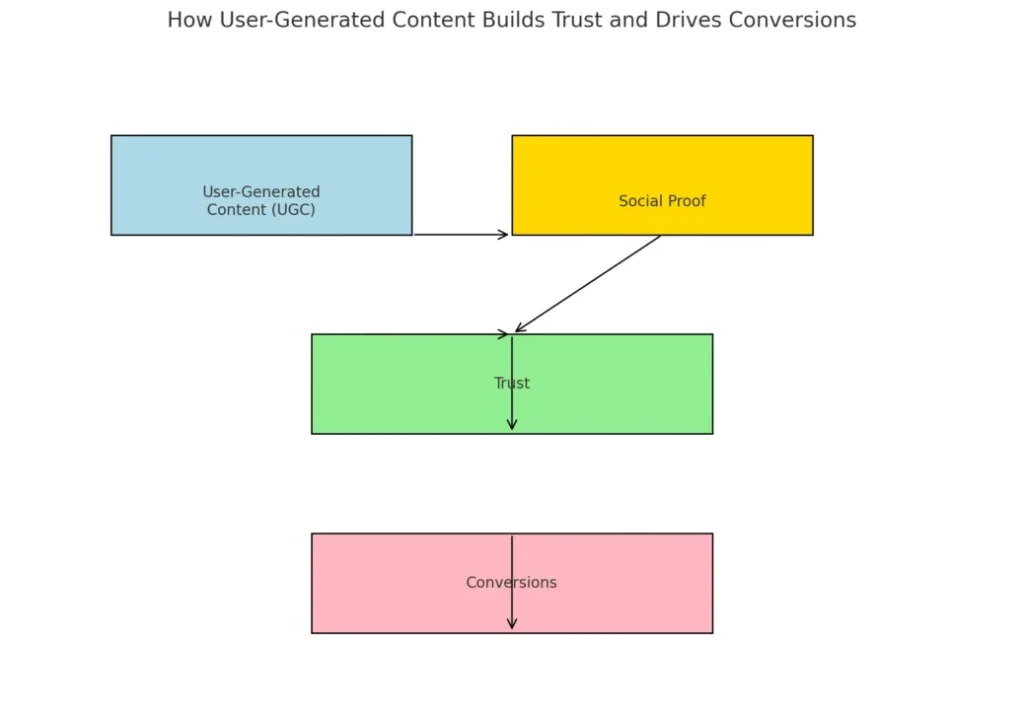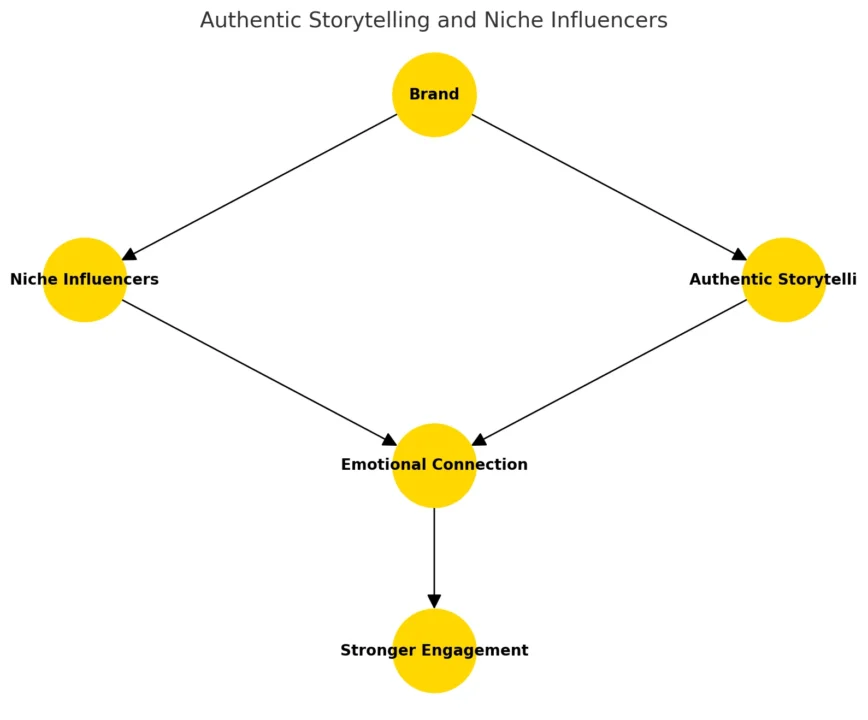Table of Contents
It’s about creating a story that resonates with your audience, captures their emotions, and forms a deeper connection. One of the most effective ways to do this is through Influencer Marketing Content. In this guide, we will also explore user-generated content, social proof, authentic storytelling, and the rising importance of niche influencers.
What Is Influencer Marketing Content?
Influencer marketing content refers to content created by influencers, typically within a specific niche, to promote a brand, product, or service. There are common formats:

- Social Media Posts: Instagram photos/videos, TikTok videos, Twitter threads, Facebook Lives
- Video Content: YouTube vlogs, product reviews, unboxing videos
- Blog Posts: Reviews, tutorials, listicles, sponsored articles
- Podcasts: Guest appearances, sponsored segments, branded episodes
- Live Streams: Q&A sessions, product demos, interactive events
The beauty of Influencer Marketing Content lies in its ability to blend naturally with the influencer’s voice. Whether it’s a TikTok dance, a YouTube unboxing video, or an Instagram story, the brand’s message is seamlessly integrated into the influencer’s existing content, making it more digestible and enjoyable for their followers.
Examples:
- A fashion blogger showcasing a new clothing line in a stylish outfit post.
- A fitness influencer demonstrating a workout routine using a specific brand of equipment.
- A tech YouTuber reviewing the latest smartphone and sharing their honest opinion.
- A food blogger creating a recipe video using a particular brand of ingredients.
- A gaming streamer playing a new game and highlighting its features to their viewers.
Influencer Partnerships: The Foundation of Storytelling
When it comes to brand storytelling, forming meaningful influencer partnerships is a critical strategy. The idea is simple: by partnering with influencers whose values align with your brand, you can amplify your brand’s message and voice.
For example, think of Nike and their long-standing partnership with athletes like Serena Williams or LeBron James. Their stories relate to resilience, hard work, and overcoming adversity, align perfectly with Nike’s ethos, making their campaigns feel more like an extension of the athlete’s own personal story rather than just another product promotion. These influencer partnerships allow Nike to tap into a vast, engaged audience who already trusts and looks up to these influencers.
Influencers have the ability to articulate a brand’s message in a way that feels less forced and more natural, which is essential for successful storytelling. By working with the right influencers, your brand can gain access to a pool of potential customers who resonate with the story you’re trying to tell.
User-Generated Content: The Voice of Your Audience

There’s a reason why user-generated content (UGC) has become a goldmine for brands: it’s authentic, unfiltered, and highly relatable. User-generated content refers to content created by your customers or fans, often featuring your product or service in a way that feels organic and genuine.
For example, brands like Glossier and Fenty Beauty have mastered the art of UGC by encouraging their customers to share their beauty routines or experiences with the products. This type of content does wonders for brand storytelling, as it allows brands to tap into real customer experiences and testimonials. When users see real people using the product in their day-to-day lives, it builds a connection that feels more real and less commercial.
Social Proof: Building Trust Through Testimonials
One of the greatest strengths of Influencer Marketing Content is its ability to generate social proof. Social proof is the psychological phenomenon where people are more likely to trust and follow the actions of others, particularly those they admire or respect.
When influencers share content featuring a brand, it’s not just about showcasing a product; it’s about showing how it fits into their lifestyle. Whether it’s a YouTube video of an influencer unboxing a new product or an Instagram post of them using it in real-time, it provides a form of social proof. Their audience, seeing someone they admire endorsing the product, is far more likely to trust the brand.
Take Daniel Wellington, for example. The watch brand relied heavily on influencer marketing to create social proof in the early stages of its rise to fame. By sending free watches to influencers, they created a tidal wave of content where influencers were seen wearing the watches. This generated a sense of social proof, and soon, many of their followers were purchasing the watches themselves, believing they were a must-have item.
For example, an influencer’s unboxing video on YouTube or their Instagram post featuring a product in everyday use provides compelling social proof. Their audience, observing someone they respect endorse the brand, is significantly more likely to develop trust and consider the product themselves.
Authentic Storytelling: The Power of Genuine Connections
The secret to successful Influencer Marketing Content is authentic storytelling. Instead, they crave stories that are real, transparent, and relatable. This is where influencer partnerships shine. Influencers build personal connections with their audiences, and when they share content featuring a brand, it feels much more genuine than a traditional advertisement.
Take Patagonia, for instance. The outdoor clothing brand has a long history of working with influencers who are passionate about environmental activism. Instead of focusing on just selling jackets, the brand uses influencers to tell stories about protecting nature, encouraging sustainability, and outdoor exploration. These stories resonate deeply with their audience, as they align with both the influencer’s values and Patagonia’s mission.
In today’s world, authentic storytelling is no longer just a nice-to-have; it’s a must-have. Consumers are looking for deeper connections with the brands they support, and influencer marketing is the perfect tool to build those connections.
Niche Influencers: Tapping into Specialized Audiences

While big names like Kim Kardashian or Cristiano Ronaldo may get attention, niche influencers are often more valuable when it comes to Influencer Marketing Content. These influencers might have smaller followings, but their audiences are highly engaged and deeply invested in specific topics, such as fitness, travel, tech, or sustainability.
For example, Sustainable Jungle, a niche influencer focused on eco-friendly living, collaborates with brands that align with their environmental mission. They may not have millions of followers, but the audience they’ve cultivated trusts them deeply. When they recommend a product, it’s seen as an authentic endorsement that carries much more weight than a traditional advertisement.
Incorporating niche influencers into your influencer strategy ensures that you’re not just broadcasting your message to the masses, but speaking directly to a highly relevant, targeted audience. These micro-communities can drive more meaningful conversations around your brand and enhance the authenticity of your storytelling.
Conclusion
Influencer Marketing Content has evolved beyond a simple promotional tool. It’s now at the heart of effective brand storytelling. Through influencer partnerships, user-generated content, social proof, and authentic storytelling, brands can create a narrative that connects with consumers on a deeper level, fostering loyalty and trust.
As we move forward, the role of niche influencers will only continue to grow, allowing brands to engage with specific audiences in a more meaningful and impactful way. Influencer marketing is not just about selling a product; it’s about telling a story, building relationships, and ultimately, creating a brand that people love and believe in.
So, if you’re looking to boost your brand storytelling, influencer marketing is a strategy you can’t afford to ignore.
FAQs
Q1: How do influencer partnerships help in brand storytelling?
Influencer partnerships amplify a brand’s message by leveraging the influencer’s authenticity, trust, and storytelling abilities. The right influencer can seamlessly integrate the brand’s story into their own, making it feel more genuine and relatable.
Q2: What is user-generated content and how does it boost brand storytelling?
User-generated content refers to content created by consumers rather than the brand itself. It boosts storytelling by providing real, unfiltered experiences with the product, helping build a stronger connection with the audience.
Q3: What is social proof and why is it important in influencer marketing?
By social proof people trust the actions of others. In influencer marketing, social proof is created when influencers showcase products, leading their followers to believe that the product is trustworthy and valuable.
Q4: How does authentic storytelling influence consumer behavior?
Authentic storytelling helps create a deeper emotional connection with consumers. When a brand’s story aligns with the values of its audience, it fosters trust and loyalty, which can lead to higher conversions and brand advocacy.
Q5: What are niche influencers and why are they valuable for brands?
Niche influencers have smaller but highly engaged audiences focused on specific topics. They are valuable because their recommendations carry more weight within their communities, leading to stronger connections and more authentic brand engagements.

